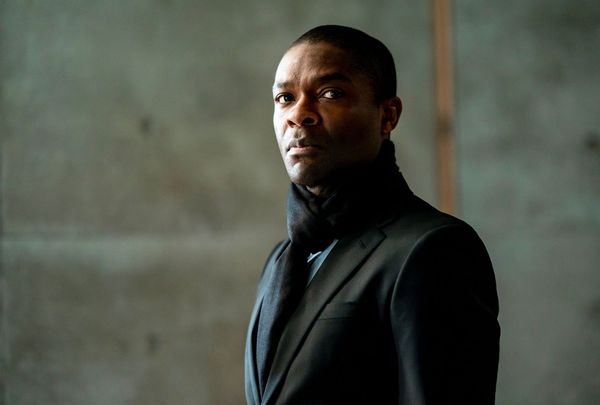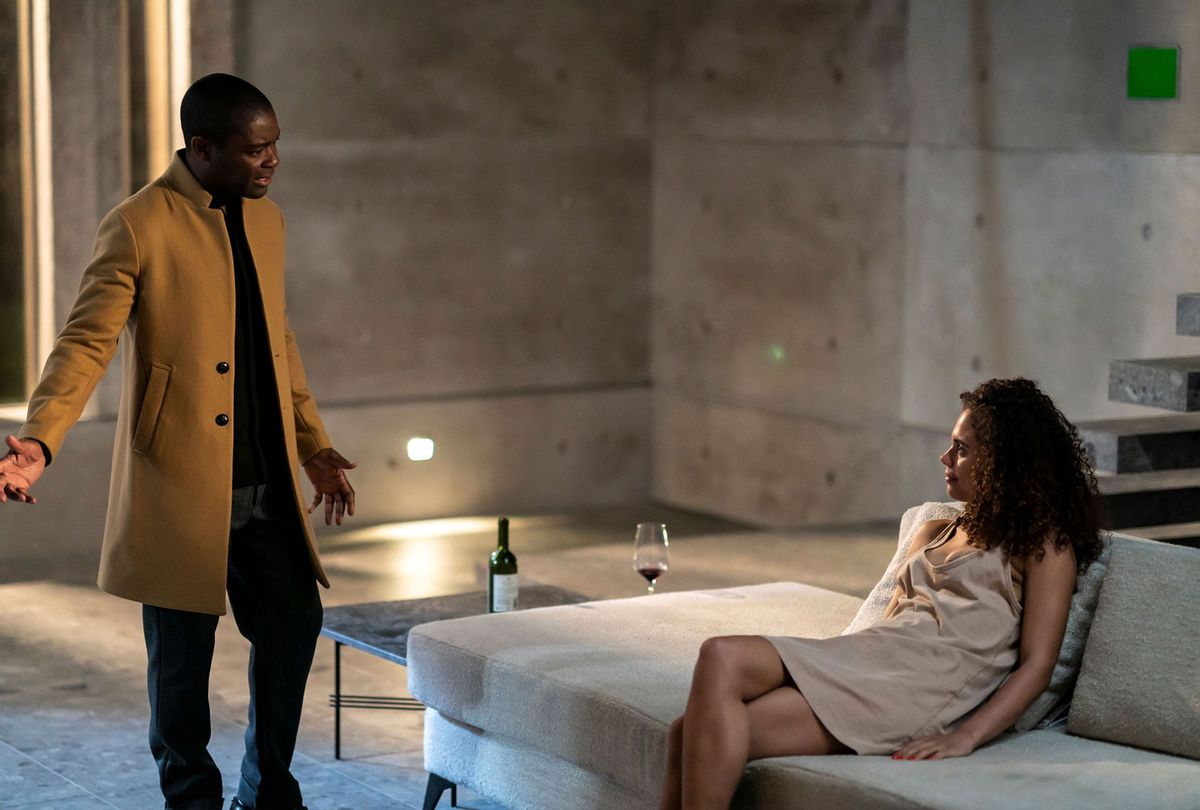Upon first seeing Edward Monkford in "The Girl Before," we can tell how exacting he is. His gaze projects strength and certainty, his voice absolute calm. This makes him attractive and unnerving to Jane Cavendish, a single woman looking for a way to reset her life. But before they initially meet, Jane becomes intrigued with the house Edward designed. And to anyone watching her house tour, its imposing grayness is tantamount to a flapping red flag several stories high.
Edward, played with stark understatement by David Oyelowo ("Selma"), adheres to an extreme version of minimalism, although he doesn't believe the term applies to him. "When you relentlessly eradicate everything unnecessary or imperfect," he tells Jane (Gugu Mbatha-Raw), "it's surprising how little is left."
The walls of his Brutalist-style rental home tell the truth of this – they are impenetrable masses devoid of embellishment. The place echoes with emptiness, although from the standard of "good design," it is impeccable. Anything interfering with form and line has been eliminated, including a handrail for the poured concrete stairs floating between the first and second levels. You know, that silly flourish that would prevent a person from accidentally falling to her death.
RELATED: Don't judge a building by its walls: Architecture is about space, and how it feels
If that doesn't scream, "Run, girl! Run!" the rental terms should have done the trick. As Edward's agent explains to Jane, he sets an affordable rent for people to live in the house "the way he intended." This means adhering to a list of more than 200 forbidden items and activities, including no snacking, no pets, no pictures or ornamentation of any kind on the walls. No carpets or rugs. No books. No drink coasters or knickknacks. No children.
Closet space is minimal, and absolutely nothing is allowed to be kept on the floor. Bizarrely, Jane is game to sign on the dotted line, even after she's told the price the tenant pays for living inside this architectural wonder, set well below market value: providing his company full access to her data in real time. The house monitors her preferred temperature and helps optimize her sleep patterns.
Other aspects are more probing, and possibly violative, such as when the house locks Jane out of essential functions such as running water until she takes a quiz to evaluate and affirm her compatibility with Edward. Then there's the matter of the home's keyless entry, controlled by a slender bracelet bearing a suspicious resemblance to a link on a chain.
Television and film have a subtle history of making coded statements through design, but a common one equates minimalism with villainy. Minimalists confound us, in that they are typically portrayed as men with means. Their lack of accoutrements have nothing to do with an inability to afford them; rather, their spartan way of living is a choice. That makes a person wonder what manner of devilry they're concealing; after all, if there's literally nothing to see in front of us, surely it's hiding elsewhere.
Westerners love surrounding themselves with heirlooms and comfortable furnishings. Our throw pillows are comfortable; our chairs overstuffed. This is true even of the average modernist. But even the snuggliest homebody can be drawn to the peaceful appeal of bare surfaces and open interior spaces, otherwise Marie Kondo's "Tidying Up" would not have been such a huge hit.
But as a recent Salon article points out, Kondo is not a minimalist. She's an evangelist for only keeping items that "spark joy" and finding peace by organizing your surroundings.
Certainly cinema has allowed heroes to cape for spare design in the right context. Who wouldn't to live in an ultra-modern glass box suspended over water like the one constructed for 2006's "The Lake House"? Scratch that – who wouldn't want to live there with Keanu Reeves?
More often, though, the onscreen minimalist is written to be quirky at best, or perhaps unfeeling, like the upper-class family in "Parasite." At their worst, they are Patrick Bateman in "American Psycho," or use their immaculate homes to cage their wives and lovers, in the way Martin Burney isolates his abused wife Laura in 1991's "Sleeping with the Enemy."
And where does Julia Roberts' Laura escape to once she gets away from her ruthless husband? A homey Victorian cottage happily cluttered with grandmotherly touches, like throw pillows, frilly curtains and a clawfoot tub. Such design elements evoke femininity and maternal comfort, a direct rebuke to the toxic masculinity of cinematic minimalism.
Despite all of this, Edward has sympathetic qualities that Oyelowo, an actor known for playing heroes, portrays by exuding gentleness between the character's cold gusts. He tells Jane he's a widower who lost a child, as she did, creating their first point of personal connection.
Naturally, Edward has darker parts of his personal history that he edits from his self-portrait that are easily discoverable online. But he's not actually deceiving Jane, since most of the sinister lore in his life is attached to that house.
 David Oyelowo in "The Girl Before" (Amanda Searle/ HBO Max)
David Oyelowo in "The Girl Before" (Amanda Searle/ HBO Max)
As implied in the series' title, Jane finds out that the previous tenant, Emma (Jessica Plummer), died on the property under mysterious circumstances. Since the series unfurls in Emma's timeline and Jane's, frequently cutting the two together, we retrace Emma's steps and witness Edward's highly structured and off-putting courtship habits.
He takes Jane to the same places he took Emma at the same junctures in their relationship. He makes the same proposal to each, offering a relationship with none of the fuss of romantic gesture, zero attachment or encumbrance, and only to last "for as long as it is perfect" and not a moment more. Even creepier is how much Jane and Emma look like each other . . . and Edward's dead wife.
Edward lives his life like he designed this house, with clear efficiency. He does not appreciate suggested alterations to the plans he makes, or tardiness, or any deviations from schedules. And he requires assurance that his tenants, each of whom he turns into lovers, agree to meet those expectations.
Minimalist men – movies and TV teaches us – are particular and stubbornly low on empathy. They are motivated to master their world by shaping everything in it precisely to their specifications, including people. This is why "Fifty Shades"' S&M hunk Christian Grey could never thrive in a craftsman – it contains too many cozy nooks and crannies.
For the similar reasons Martin Vanger's house in 2011's "The Girl With The Dragon Tattoo" is made without comfort in mind, and the tech CEO's isolated lair in 2014's "Ex Machina" hits us as impressive and sinister all at once. Minimalist men create dungeons, not sanctuaries.
This is also why, in real life, our collective image of Brad Pitt as a dream boat was dented by that famous 2006 Jennifer Aniston profile in Vanity Fair when she revealed that in the home she once shared with Pitt, chicness was more important than ease. "Brad and I used to joke that every piece of furniture was either a museum piece or just uncomfortable," Aniston told the interviewer.
I ask you, which is the greater crime: living in a dysfunctional marriage without a decent couch to retreat to on your worst days, or having the husband who insisted on purchasing that couch cheat on you with Angelina Jolie?
Want a daily wrap-up of all the news and commentary Salon has to offer? Subscribe to our morning newsletter, Crash Course.
Taking all of these examples into account, this is why "The Girl Before"'s creator J.P. Delaney, who also wrote the 2016 novel upon which the series is based, has a brilliant antagonist in the fiercely minimalist Edward: We'd see him as a villain regardless of whether he's committed the crimes of which he's suspected. He has secrets, this barren elegant house tells us, for if he didn't, he would pad the place with comfort and softness. But rugs and wall hangings tell stories and would absorb the memories that slide off every surface of his space.
He has a zealous devotion to control, treating his designs and the people in them like canvases onto which he can project his desires. This makes him seem protective, proven by each woman, at some point, telling him how safe they feel in his presence.
But that ability to drop one's guard also makes him as dangerous as that floating staircase. "Let's face it," Jane says, "Anyone who could build this place could probably do pretty much anything they set their mind to." That's a frightening thought . . . but honestly, a little freeing too, as all clean slates should be.
All four episodes of "The Girl Before" are streaming on HBO Max. Watch a trailer for it, via YouTube.
More stories like this:

Shares